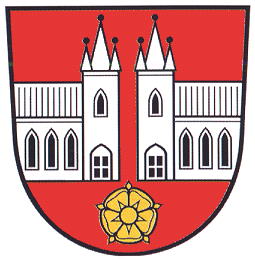Grossengottern: Difference between revisions
Knorrepoes (talk | contribs) m (Text replacement - "/Arms of " to "/Arms (crest) of ") |
Knorrepoes (talk | contribs) m (Text replacement - "{{media}}" to " {{de1}} {{media1}}") |
||
| Line 24: | Line 24: | ||
The rose represent the Luther rose, as the village is predominantly Lutheran. | The rose represent the Luther rose, as the village is predominantly Lutheran. | ||
{{ | |||
{{de1}} | |||
{{media1}} | |||
[[Civic Heraldry Literature - Germany|'''Literature''']]: Ulle, 1998 | [[Civic Heraldry Literature - Germany|'''Literature''']]: Ulle, 1998 | ||
Revision as of 12:37, 26 December 2022
This page is part of the German heraldry portal Deutsche Wappensammlung |
Heraldry of the World |
|
German heraldry:
|
Selected collector's items from Germany:
|
GROSSENGOTTERN
State : Thüringen
District (Kreis) : Unstrut-Hainich Kreis
| German |
In Rot zwei silberne, mit den Türmen zueinandergekehrte Kirchen; im Schildfuss eine goldene Rose. |
| English | No blazon/translation known. Please click here to send your (heraldic !) blazon or translation |
Origin/meaning
The arms are based on the old parish seal, known since 1747. The two churches represent the two former parishes of St. Walpurgis and St. Martinus, which were originally separate, but during the late Middle Ages the two grew together and developed into a town. The towers show small guard towers, as already in 1340 town rights were granted, which were confirmed in 1666. The town needed some defense structures, but dit not have a wall, hence the small watch towers.
The rose represent the Luther rose, as the village is predominantly Lutheran.
Literature: Ulle, 1998


